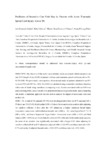Mostrar o rexistro simple do ítem
Predictors of intensive care unit stay in patients with acute traumatic spinal cord injury above T6
| dc.contributor.author | Esmorís, Inés | |
| dc.contributor.author | Galeiras, Rita | |
| dc.contributor.author | Ferreiro-Velasco, María Elena | |
| dc.contributor.author | Pértega-Díaz, Sonia | |
| dc.date.accessioned | 2023-02-07T07:31:57Z | |
| dc.date.issued | 2022-10 | |
| dc.identifier.citation | Esmorís-Arijón I, Galeiras R, Ferreiro Velasco ME, Pértega Díaz S. Predictors of intensive care unit stay in patients with acute traumatic spinal cord injury above T6. World Neurosurg. 2022 Oct;166:e681-e691. | es_ES |
| dc.identifier.issn | 1878-8750 | |
| dc.identifier.uri | http://hdl.handle.net/2183/32435 | |
| dc.description | Observational study | es_ES |
| dc.description.abstract | [Abstract] Objective: The objective of this study was to identify factors associated with the intensive care unit (ICU) length of stay (LOS) of patients with an acute traumatic spinal cord injury above T6. Methods: We performed a retrospective, observational study of patients admitted to an ICU between 1998 and 2017 (n = 241). The LOS was calculated using a cumulative incidence function, with events of death being considered a competing event. Factors associated with the LOS were analyzed using both a cause-specific Cox proportional hazards regression model and a competing risk model. A multistate approach was also used to analyze the impact of nosocomial infections on the LOS. Results: A total of 211 patients (87.5%) were discharged alive from the ICU (median LOS = 23 days), and 30 (12.4%) died (median LOS = 11 days). In the multivariate analysis after adjusting for variables collected 4 days after the ICU admission, a higher American Spinal Injury Association motor score (subdistribution hazards ratio [sHR] = 1.01), neurological level C5-C8 (HR = 0,64), and lower Sequential Organ Failure Assessment score (sHR = 0.82) and fluid balance (sHR = 0.95) on day 4 were linked to a lower LOS in this unit. In the multivariate analysis, the onset of an infection was significantly associated with a longer LOS when adjusting for variables collected both at ICU admission (adjusted sHR = 0.62; 95% confidence interval = 0.50-0.77) and on day 4 (adjusted hazards ratio = 0.65; 95% confidence interval = 0.52-0.80). Conclusions: After adjusting the data for conventional variables, we identified a lower American Spinal Injury Association motor score, injury level C5-C8, a higher Sequential Organ Failure Assessment score on day 4, a more positive fluid balance on day 4, and the onset of an infection as factors independently associated with a longer ICU LOS. | es_ES |
| dc.language.iso | eng | es_ES |
| dc.publisher | Elsevier | es_ES |
| dc.relation.uri | https://doi.org/10.1016/j.wneu.2022.07.072 | es_ES |
| dc.subject | Acute traumatic spinal cord | es_ES |
| dc.subject | Critical care | es_ES |
| dc.subject | Infection | es_ES |
| dc.subject | Length of stay | es_ES |
| dc.subject | Sequential Organ Failure Assessment score | es_ES |
| dc.subject | Survival | es_ES |
| dc.title | Predictors of intensive care unit stay in patients with acute traumatic spinal cord injury above T6 | es_ES |
| dc.type | info:eu-repo/semantics/article | es_ES |
| dc.rights.access | info:eu-repo/semantics/embargoedAccess | es_ES |
| dc.date.embargoEndDate | 2023-09-28 | es_ES |
| dc.date.embargoLift | 2023-09-28 | |
| UDC.journalTitle | World Neurosurgery | es_ES |
| UDC.volume | 166 | es_ES |
| UDC.startPage | e681 | es_ES |
| UDC.endPage | e691 | es_ES |
Ficheiros no ítem
Este ítem aparece na(s) seguinte(s) colección(s)
-
INIBIC- REUMA - Artigos [184]






